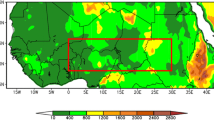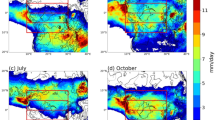Abstract
The aim of this study is to elucidate the primary factors influencing the development, strength, and longevity of mesoscale convective systems (MCSs) in southwest Iran. Focusing on dynamic and thermodynamic factors, this research investigates their impact on MCSs’ maximum area, longevity, and precipitation characteristics. The study reveals that MCS characteristics are intricately linked to environmental factors such as humidity, convective available potential energy (CAPE), and low-level wind shear, predominantly within the Red Sea convergence zone. These factors are, in turn, influenced by larger atmospheric phenomena like Sudan’s low, Saudi Arabia’s high, and the Azores high. Multiple linear regression analysis identifies low-level wind shear along the Red Sea convergence zone and the 300 hPa wind speed along the subtropical jet stream as significant predictors for both the maximum and mean precipitation of MCSs. Notably, CAPE over the west of the Red Sea emerges as crucial for maximum precipitation, while sensible heat flux over Eastern Europe is key for mean precipitation estimation. The findings also underscore that humidity variables and 850 hPa wind speed are vital in determining the longevity and area of MCSs. This study contributes to a better understanding of the environmental conditions influencing MCS occurrence, aiding in the prediction of heavy precipitation events in subtropical regions like southwest Iran.













Similar content being viewed by others
Data availability
IRW brightness temperature of Meteosat imagery are available from the European Organisation for the Exploitation of Meteorological Satellites at https://www.eumetsat.int/ and Reanalysis datasets (ERA5) are available from the European Centre for Medium-Range Weather Forecasts (ECMWF) at https://cds.climate.copernicus.eu.
References
Alghamdi A, Harrington J (2023) The symmetry and structural characteristics of the core of the Arabian Subtropical Anticyclone and associated surface climatology over Arabia: a spatial perspective. Atmos Res 281:106482
Alijani B (2002) Variation of 500 hPa flow patterns over Iran and surrounding areas and their relationship with climate of Iran. Theor Appl Climatol 72:41–54
Almazroui M, Awad A, Islam M, Al-Khalaf A (2014) A climatological study: wet season cyclone tracks in the East Mediterranean region. Theor Appl Climatol 120(1–2):351–365
Awad A, Mashat A (2019) Climatology of the autumn Red Sea trough. Theor Appl Climatol 135(3-4):1545–1558
Burke PC, Schultz DM (2004) A 4-yr climatology of cold-season bow echoes over the continental United States. Wea Forecasting 19:1061–1074
Chen Q, Fan J, Hagos S, Gustafson WI, Berg LK (2015) Roles of wind shear at different vertical levels: cloud system organization and properties. J Geophys Res Atmos 120:6551–6574
Coniglio MC, Stensrud DJ (2001) Simulation of a progressive derecho using composite initial conditions. Mon Weather Rev 129:1593–1616
Corfidi SF (2003) Cold pools and MCS propagation: forecasting the motion of downwind-developing MCSs. Wea Forecasting 18:997–1017
Farajzadeh M, Karimi M, Ghaemi H, Mobasheri MR (2007) Studying the moisture flux over west of Iran. J Appl Sci 7(20):3023–3030
Fovell RG, Ogura Y (1989) Effect of vertical wind shear on numerically simulated multicell storm structure. J Atmos Sci 46:3144–3176
Gerami M (2023) Temporal-spatial analysis and mechanism of convective precipitation in Iran. Dissertation, University of Tehran
Gimeno L, Dominguez F, Nieto R, Trigo R, Drumond A, Reason CJC, Taschetto A, Ramos AM, Kumar R, Marengo J (2016) Major mechanism of atmospheric moisture transport and their role in extreme precipitation events. Annu Rev Env Resour 41:117–141
Houston AL, Niyogi D (2007) The sensitivity of convective initiation to the lapse rate of the active cloud-bearing layer. Mon Weather Rev 135:3013–3032
Jafari M, Lashkari H (2020) Study of the relationship between the intertropical convergence zone expansion and the precipitation in the southern half of Iran. J Atmos Sol Terr Phys 210:105439
Janowiak JE, Joyce RI, Yarosh Y (2001) A real-time global half-hourly pixel resolution infrared dataset and its applications. Bull Am Meteorol Soc 82:205–217
Johns RH, Doswel CA (1992) Severe local storms forecasting. Weather Forecast 8:559–569
Keikhosravi M, Masoodian A, Balling RC Jr, Montazeri M (2020) Evaluation of the TRMM 3B42 product for extreme precipitation analysis over southwestern Iran. Adv Space Res 66:2094–2112
Kim HW, Lee DK (2006) An observational study of mesoscale convective systems with heavy rainfall over the Korean Peninsula. Weather and Forecast 21:125–148
Laing AG, Fritsch JM (1997) The global population of mesoscale convective complexes. Q J Roy Meteorol Soc 123(538):389–405
Lashkari H (2004) The mechanism of forming, deepening and development of Sudan low and its effect in precipitation south western of Iran. Geogr Res Quarterly 35(46):1–18 https://sid.ir/paper/5419/en
Lewis MW, Gray SL (2010) Categorisation of synoptic environments associated with mesoscale convective systems over the UK. Atmos Res 97:194–213
Mofid A (2005) Synoptic climatology of heavy rainfalls with origin of Red Sea region in the Middle East. Geogr Res 19(475):71–93
Mofid A, Zarin A (2005) The synoptic study of low pressure systems of the Sudan in heavy rain falls in Iran. Geogr Res 20(277):113–136
Mofid A, Zarin A (2006) Synoptic analysis of the nature of Sudan low pressure systems (case study: December 2001 storm). Territory 2(6):26–50
Mohammadi Z, Lashkari H (2018) Effects of spatial movement of Arabia subtropical high pressure and subtropical jet on synoptic and thermodynamic patterns of intense wet years in the south and south west Iran. Phys Geogr Res Quarterly 50(3):491–509
Mohammadi F, Lashkari H (2020) Determination of long-term changes in the rainfall penetration domain of Sudan low in Iran during the period 1976–2017. J Atmos Sol Terr Phys 203(2020):1–9
Morrison DF (1976) Multivariate statistical methods. McGraw-Hill, New York
Marwitz JD (1972) Precipitation efficiency of thunderstorms on the High Plains. J Res Atmos 6:367–370
Moncrieff MW (1992) Organized convective systems: archetypal dynamical models, mass and momentum flux theory, and parametrization. Q J Roy Meteorol Soc 118(507):819–850
Moncrieff MW, Liu C (1999) Convection initiation by density currents: role of convergence, shear, and dynamical organization. Mon Weather Rev 127:2455–2464
Nasiri B, Ghaemi H (1999) Analyzing the synoptic and dynamic pattern of Karkheh and Dez rainfall. Geogr Res 14(3-4):177–186
Parandeh A (1999) The synoptic invesgtigation of the flood - prevoking systems in river basin DALAKY. Dissertation, Tarbiat Modares University
Parker MD, Johnson RH (2000) Organizational modes of midlatitude mesoscale convective systems. Mon Weather Rev 128:3413–3436
Peters JM, Schumacher RS (2014) Objective categorization of heavy-rain-producing MCS synoptic types by rotated principal component analysis. Mon Weather Rev 142:1716–1737
Qie K, Qie X, Tian W (2021) Increasing trend of lightning activity in the South Asia region. Sci Bull 66:78–84. https://doi.org/10.1016/j.scib.2020.08.033
Rafati S, Fathnia A, Karimi M (2015) Assessment of the low level jets effects on MCSs formation in the southwest Iran. Phys Geogr Res 48(1):69–82
Rafati S, Karimi M (2017) Assessment of mesoscale convective systems using IR brightness temperature in the southwest of Iran. Theor Appl Climatol 129:539–549
Rafati S (2021) Investigation of spatial properties and environmental - synoptic conditions of MCSs formation causing flood in March 2019. J Spat Anal Environ Hazards 7(4):65–88
Rafati S, Fatahi E (2022) Effects of regional thermodynamic parameters on lightning flash density as an indicator of convective activity over southwest Iran. Pure Appl Geophys 179:2011–2025
Rahimi D, Khoshhal J, Alizadeh T (2010) The statistical-synoptic analysis of heavy showers in arid regions of Iran: Kerman Province. J Geogr Reg Develop 8(14):1–19
Raziei T, Mofidi A, Santos JA, Bordi I (2011) Spatial patterns and regimes of daily precipitation in Iran in relation to large-scale atmospheric circulation. Int J Climatol 32(8):1226–1237
Raziei T, Bordi I, Santos JA, Mofidi A (2012) Atmospheric circulation types and winter daily precipitation in Iran. Int J Climatol 33(9):2232–2246
Raofifard (1997) Synoptic analysis of floods in Qom province. Dissertation, Islamic Azad University
Robe FR, Emanuel KA (2001) The effect of vertical wind shear on radiative–convective equilibrium states. J Atmos Sci 58(11):1427–1445
Rotunno R, Klemp JB, Weisman ML (1988) A theory for strong, long-lived squall lines. J Atmos Sci 45(3):463–485
Sabziparvar A (1991) Synoptic investigation of flood-causing systems in southwest Iran. Dissertation, University of Tehran
Soltani M, Hamelers B, Mofidi A, Hoeven T, Staal A, Dekker S, Arnault J, Laux P, Kunstmann H, Lanters M (2022) A 20-year satellite-reanalysis-based climatology of extreme precipitation characteristics over the Sinai Peninsula. Earth Syst Dynam. https://doi.org/10.5194/esd-2022-10
Thorpe AJ, Miller MJ, Moncrieff MW (1982) Two dimensional convection in non-constant shear: a model of mid-latitude squall lines. Quart J Roy Meteor Soc 108:739–760
Toreti A, Giannakaki P, Martius O (2016) Precipitation extremes in the Mediterranean region and associated upper-level synoptic-scale flow structures. Climate Dynam 47:1925–1941
Uccellini LW, Johnson DR (1979) The coupling of upper and lower tropospheric jet streaks and implications for the development of severe convective storms. Mon Weather Rev 107:682–703
Vries A, Tyrlis E, Edry D, Krichak S, Steil B, Lelieveld J (2013) Extreme precipitation events in the Middle East: dynamics of the active red sea trough: active red sea trough dynamics. J Geophys Res-Atmos 118(13):7087–7108
Wang Q, Li Z, Guo J, Zhao C, Cribb M (2018) The climate impact of aerosols on the lightning flash rate: is it detectable from long-term measurements. Atmospheric Chem Phys 18:12797–12816
Weisman ML, Klemp JB, Rotunno R (1988) Structure and evolution of numerically simulated squall lines. J Atmos Sci 45:1990–2013
Weisman ML, Rotunno R (2004) A theory for strong long-lived squall lines. J Atmos Sci 61(4):361–382
Xu KM, Arakawa A, Krueger SK (1992) The macroscopic behavior of cumulus ensembles simulated by a cumulus ensemble model. J Atmos Sci 49(24):2402–2420
Zipser EJ, Salio P, Nicolini M (2004) Mesoscale convective systems activity during SALLJEX and the relationship with SALLJ. CLIVAR Exchanges 29:14–19
Author information
Authors and Affiliations
Contributions
The research design, analysis, and writing were done by SR. Data collection, material preparation, and some analysis were performed by ZK and SB.
Corresponding author
Ethics declarations
Competing interests
Authors have no relevant financial or non-financial interests to disclose.
Additional information
Publisher’s note
Springer Nature remains neutral with regard to jurisdictional claims in published maps and institutional affiliations.
Rights and permissions
Springer Nature or its licensor (e.g. a society or other partner) holds exclusive rights to this article under a publishing agreement with the author(s) or other rightsholder(s); author self-archiving of the accepted manuscript version of this article is solely governed by the terms of such publishing agreement and applicable law.
About this article
Cite this article
Rafati, S., Khazaei, Z. & Bahramnejad, S. Investigation of thermodynamics and dynamic factors affecting the development, strength, and longevity of mesoscale convective systems. Theor Appl Climatol 155, 3719–3737 (2024). https://doi.org/10.1007/s00704-024-04844-7
Received:
Accepted:
Published:
Issue Date:
DOI: https://doi.org/10.1007/s00704-024-04844-7




